Trying to understand the difference between free chlorine vs combined chlorine? Not too sure what Total Chlorine is?
Then you’ve stumbled upon the perfect post. Keep reading
Every swimming pool needs some kind of sanitizer, whether it’s natural or chemical based. And for most pool owners, the chemical of choice is chlorine. But chlorine isn’t a chemical that’s necessarily simple. Sure, you add it to your swimming pool and it keeps your water clean, but how does that happen? Moreso, what role does each type of chlorine (Free Chlorine, Combined Chlorine, and Total Chlorine) play?
Learn the answers in this post where we discuss free chlorine vs combined chlorine and much more.
Free Chlorine vs Combined Chlorine
& Understanding Total Chlorine



What is free chlorine?
Understanding free chlorine is really easy when you consider the phrase itself: “free chlorine.” And that’s because free chlorine is unused chlorine that’s still free to sanitize. In other words, it’s the available chlorine in your water, and it’s what you measure when testing your water.
An ideal range for free chlorine sits between 1 -3 ppm.
Think of free chlorine as chlorine that is active.
What is combined chlorine?
When available chlorine comes in contact with contaminants in your water, the sanitization process takes places. Once it’s over, you end up with a cleaner and healthier pool. But, there’s a bi-product of this process, and it’s chloramines.
And chloramines represent one thing: used up chlorine, or combined chlorine
(They’re also responsible for the intense smell of chlorine you may smell every now and then)
So, in short, combined chlorine is chlorine that’s already been used for sanitization.
You can measure your combined chlorine by subtracting your free chlorine from your total chlorine
or, TC – FC = CC
But wait, what’s total chlorine?
Free Chlorine vs Total Chlorine in swimming pools
Well, you already know what free chlorine is, but we haven’t defined total chlorine. And that’s because total chlorine is the total amount of both used AND active chlorine in your water. Or in order words, it’s the sum between your free chlorine and combined chlorine levels.
So when you think free chlorine vs combined chlorine, remember this simple formula:
Free Chlorine + Combined Chlorine = Total Chlorine | FC + CC = TC
[Having trouble keeping your chlorine levels up? This pool care schedule makes it easy]
But all this still leaves one major question:
How exactly does chlorine work?
How Chlorine Works



Here’s an overview of the sanitization process for chlorine
It all starts when you add chlorine to your pool.
As soon as the chlorine begins mixing with your water, breakdown occurs, and numerous chemical compounds are formed. Of these compounds, the most prominent are hypochlorous acid and hypochlorite ions.
Both are essential to sanitizing your water and work by oxidizing the bacteria and contaminants in your pool. But while hypochlorous acid works almost instantly within seconds of contact, hypochlorite ions utilize a slower, more drawn out oxidation process.
When a reaction between free chlorine and the contaminants in your pool occurs, the bi-product is chloramines or combined chlorine.
How much chlorine do I add to my pool?
How to raise free chlorine
Since pools come in a wide range of different shapes and sizes, there isn’t a “one-size-fits-all” amount of chlorine to add to your water. Every pool will require a different amount, but that amount is relative to two factors:
Your free chlorine and combined chlorine.
Reference the directions printed on the packaging of the chlorine product you purchased. You should find a reference to how much chlorine is needed according to the size of your pool. Usually, a scoop or dose of chlorine increases the ppm of your free chlorine by a particular amount. But again, this increase is also entirely dependent on the size of your pool.
So work like an engineer and add one scoop of chlorine to your water, wait a little bit, then test your water. Make a note of how much chlorine you used, and how much it raised your Free Chlorine by (in ppm, parts per million). This will give you a fairly accurate number to gauge how much chlorine you’ll need in the future.
Wrapping it all up
So let’s recap.
We categorize chlorine into three main categories: Free Chlorine, Combined Chlorine, and Total Chlorine.
Free chlorine is what’s still active and available to sanitize your pool. Combined chlorine is what’s already been used for sanitization, and is physically represented by chloramines. And of course, total chlorine is calculated by adding your free chlorine and combined chlorine together.
Hopefully, now you have a solid understanding of free chlorine vs combined chlorine, and how it all works. But as a pool owner, you already know that there are a few other chemicals essential to properly balancing your water. Chemicals that we didn’t go over in this post.
But, that’s only because we talked all about pool chemistry in this post instead, check it out: Understanding Pool Chemistry
And if you still have a few other questions about pool ownership, you’ll likely find the answers in our Pool Owner Guide


